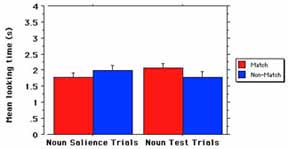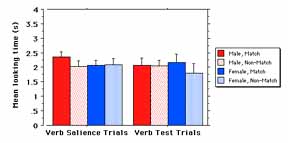ABSTRACT
In this poster, a new "split-screen" adaptation of the preferential looking paradigm is introduced. Because the stimuli are displayed on a single video monitor and played from a standard VCR, this procedure allows for more controlled and reliable presentation of stimuli than is often possible in other instantiations of this paradigm.
INTRODUCTION Preferential looking paradigms have had wide use within the developmental literature to study topics ranging from infants' visual acuity to their knowledge of bi-modal events, from infants' visual expectancies to their acquisition of language. In particular, within the field of language development, preferential looking paradigms have met with considerable success in testing very early language comprehension.
Their principal advantages include: 1) tight control over experimental stimuli, 2) requiring no overt action on the part of the child, and 3) allowing for presentation of dynamic stimuli (enabling testing of verbs and predicates). Unfortunately, this experimental power is often bought at the expense of great technological expertise and effort, which can lead to increased opportunity for experimental error.
ADVANTAGES
- Tight control over presentation.
- No overt action required.
- Dynamic stimuli.
- Portable & Cost Effective.
- User Friendly.
- Speed (Videos in less than a day).
STIMULI
"Do you see the shoe?"
METHOD In this poster, a new "split-screen" adaptation of the preferential looking paradigm was used. In it, two films are presented simultaneously on one video monitor, one film on the left side of the monitor and one film on the right side of the monitor. Because the stimuli are now presented on a single screen, the technological difficulties and expense inherent in synchronizing multiple VCR's, as in previous two-screen paradigms, are eliminated. This drastically reduces the potential for experimenter error, provides for much finer synchronization of films, and allows tighter control of other factors related to two monitors, factors like brightness, tint, head position, etc. This procedure also has the added benefit of shortening setup time and dramatically reducing the overall cost of the method.
The new "split-screen" paradigm was validated using the stimuli from an earlier 2-screen preferential looking study of word endings in 19-month-olds (Golinkoff, Hirsh-Pasek, & Schweisguth, in press). In that study and in the current one, infants were shown pairs of films representing two actions while one of the actions was requested. For example, infants might see an actor "running" on the left side of the screen and an actor "turning" on the right side while simultaneously hearing an audio track requesting they look at "running." Target verbs were counterbalanced, as was the side of the match. The hypothesis, as in all preferential looking procedures, was that infants will look longer at the side displaying the matching action.
RESULTS
Infants (N=24; mean age = 19.4mo) did show reliable looking preferences toward the film that matched the requested verb. In addition, their looking times and responses were very similar to the previous two screen version of this task.
The "split-screen" paradigm was extended to a younger age using two sets of nouns and verbs selected from the Fenson, et. al., SRCD Monograph as words known to be part of the vocabularies of young infants. In this manner, we hoped to test children's knowledge of both object and action labels.
Thus, infants might see a car on the left side of the screen and a shoe on the right side while simultaneously hearing an audio track requesting they look at "shoe." Conversely, as in the previous study, they might see a character "hugging" on one side of the screen and "drinking" on the other while the audio asked for "hugging."
Target words were again counterbalanced, as was the side of the match. The hypothesis, once again, was that infants would look longer at the side displaying the matching word.
RESULTS


Infants (N=24, mean age=13.9mo) did show reliable looking preferences toward the film that matched the requested object. However, they did not show reliable preferences for action words, although girls did show a trend in that direction.
As was found in previous two-screen studies, 19-month-old infants indicated they understood action words. In addition, 14-month-olds demonstrated a competent understanding of nouns, but only a tenuous grasp of verbs, at best. While these results give reliable evidence for the development of the early lexicon, they are most notable for their methodological implications.
The "split-screen" procedure represents a new wave of controlled testing, despite reducing the distances and size of the stimuli. More specifically, we have a validation of how this paradigm can work for the study of early language. Because this adaptation can replicate findings in a more user friendly way with reduced technological complexity and experimental error, it makes the preferential looking procedure more accessible to researchers and practitioners alike.
| Coments to: ghollich@yahoo.com |
Last Modified: Sept 20, 1999 |